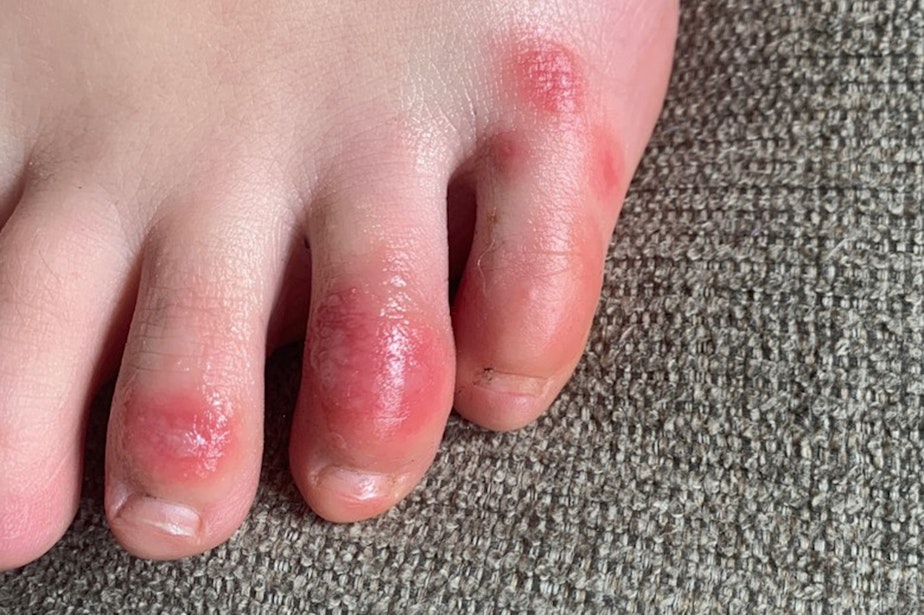Are those ‘Covid toes,’ or should you be wearing slippers?

Christine Jensen of Seattle noticed weird red spots on her feet and that her hands were “inflamed and kind of tender to the touch.”
She made an appointment with her dermatologist over Zoom in April, and the dermatologist said there might a connection to the coronavirus.
“That definitely started to trigger a little bit of alarm for me,” said Jensen, a legislative analyst with King County. "We had talked about how, in the month of March, I had what seemed like possibly some flu-like symptoms for about a week and a half.”
The syndrome is being called “Covid toe,” but how (or even whether) Covid-19 actually causes it is a mystery, one that researchers in the Seattle area are trying to solve. Many of the people with this affliction test negative for coronavirus, but doctors still believe there may be a connection.
Dr. Andrea Kalus, a professor at the University of Washington, was Jensen’s dermatologist, and she has seen a few patients with Covid toe symptoms.
“They can be itchy, they can be painful,” Kalus said. “They can go from being like a red purple spot to turning into a blister, and the skin can even sort of fall off the top.”
Kalus is collaborating on a Covid toe research project with Dr. Keith Elkon’s research team in the rheumatology department at the University of Washington School of Medicine.
Sponsored
How do researchers know this skin condition is connected to the coronavirus? They don’t.
“Unfortunately, we can't answer that yet,” Kalus said.
Because here’s the strange thing: “So far none of the patients we have seen in dermatology at UW have been positive by PCR test or antibody test for Covid,” Kalus said. And globally, she said, researchers haven’t established a clear connection between positive coronavirus tests and Covid toe.
Kalus said that’s one of the things researchers at the University of Washington are puzzling over. It could be the Covid tests aren’t looking for all of the right “markers of this disease with the optimal timing in the infection or immune response,” Kalus said.
There’s another possibility. It turns out Covid toe looks like a condition called chilblains, also known as pernio.
Sponsored
“It's usually a cold and damp environment that kind of triggers this reaction in toes. And so people who are in the Northwest, this actually isn't a super uncommon thing,” she said.
That means you may think you have Covid toe, but are just wandering about your cold house in bare feet, which a lot of people are doing these days, while working from home.
But Kalus and other researchers suspect this is different. “We’re absolutely seeing this in numbers we haven’t seen previously,” she said.
Chilblains involve inflammation of the small blood vessels in your skin, which is similar to more serious inflammation that’s also likely caused by Covid-19. Some kids, for example, are getting a rare inflammatory disease that's being linked to Covid-19, called pediatric multisystem inflammatory syndrome. At least two cases have been identified in the Seattle area.
It involves a “hyper response” of the child’s immune system to the virus, according to Dr. Michael Portman, who directs pediatric cardiovascular research at Children’s Hospital in Seattle, which had the first documented case in the state. Like Covid toe, the condition can lead to inflammation of the blood vessels. But unlike Covid toe, it can affect the heart’s arteries, for example, leading to coronary aneurysms.
Sponsored
Jane Buckner, a rheumatologist and president of the Benaroya Research Institute in Seattle, said that overreaction by the immune system may be the key link to Covid-19 in both instances. She has a number of patients with lupus and other diseases who get chilblains.
“The majority of the people who have gotten it over the years, we've never known why,” Buckner said. “But the concept that it has been triggered by a virus is pretty likely.”
Buckner is also hopeful that treatments for more serious complications caused by Covid-19 are coming soon. She pointed out that there are a number of immune-suppressing drugs already being used to treat other immune disorders, which might help treat patients with Covid-19.
“I am quite optimistic that we are going to understand many facets of this disease in a short period of time, because of the emphasis that we're all putting on it,” she said.
So what about Christine Jensen who had a suspected case of Covid toe? She got tested for Covid-19 and a second test for antibodies, and both came up negative. “Now everything has cleared up," she said. "Probably lasted just shy of a month.”
Sponsored
But her dermatologist, Dr. Kalus, still believes this and other cases may be connected to the coronavirus, even though she and other researchers haven’t yet figured out how.




